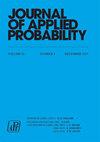大张量乘上随机算子谱投影的持久性
IF 0.7
4区 数学
Q3 STATISTICS & PROBABILITY
引用次数: 0
摘要
研究证明,对于可数张量积上的随机算子族,在平稳地依赖于参数的情况下,任何谱投影都会平稳地持续存在,其中平稳性是使用基于多布鲁欣思想的规范来定义的。由此,我们创建了具有谱间隙的随机算子族的严格扰动理论。我们通过推导三态概率蜂窝自动机的有效慢速双态动力学来说明这一点。本文章由计算机程序翻译,如有差异,请以英文原文为准。
Persistence of spectral projections for stochastic operators on large tensor products
It is proved that for families of stochastic operators on a countable tensor product, depending smoothly on parameters, any spectral projection persists smoothly, where smoothness is defined using norms based on ideas of Dobrushin. A rigorous perturbation theory for families of stochastic operators with spectral gap is thereby created. It is illustrated by deriving an effective slow two-state dynamics for a three-state probabilistic cellular automaton.
求助全文
通过发布文献求助,成功后即可免费获取论文全文。
去求助
来源期刊

Journal of Applied Probability
数学-统计学与概率论
CiteScore
1.50
自引率
10.00%
发文量
92
审稿时长
6-12 weeks
期刊介绍:
Journal of Applied Probability is the oldest journal devoted to the publication of research in the field of applied probability. It is an international journal published by the Applied Probability Trust, and it serves as a companion publication to the Advances in Applied Probability. Its wide audience includes leading researchers across the entire spectrum of applied probability, including biosciences applications, operations research, telecommunications, computer science, engineering, epidemiology, financial mathematics, the physical and social sciences, and any field where stochastic modeling is used.
A submission to Applied Probability represents a submission that may, at the Editor-in-Chief’s discretion, appear in either the Journal of Applied Probability or the Advances in Applied Probability. Typically, shorter papers appear in the Journal, with longer contributions appearing in the Advances.
 求助内容:
求助内容: 应助结果提醒方式:
应助结果提醒方式:


